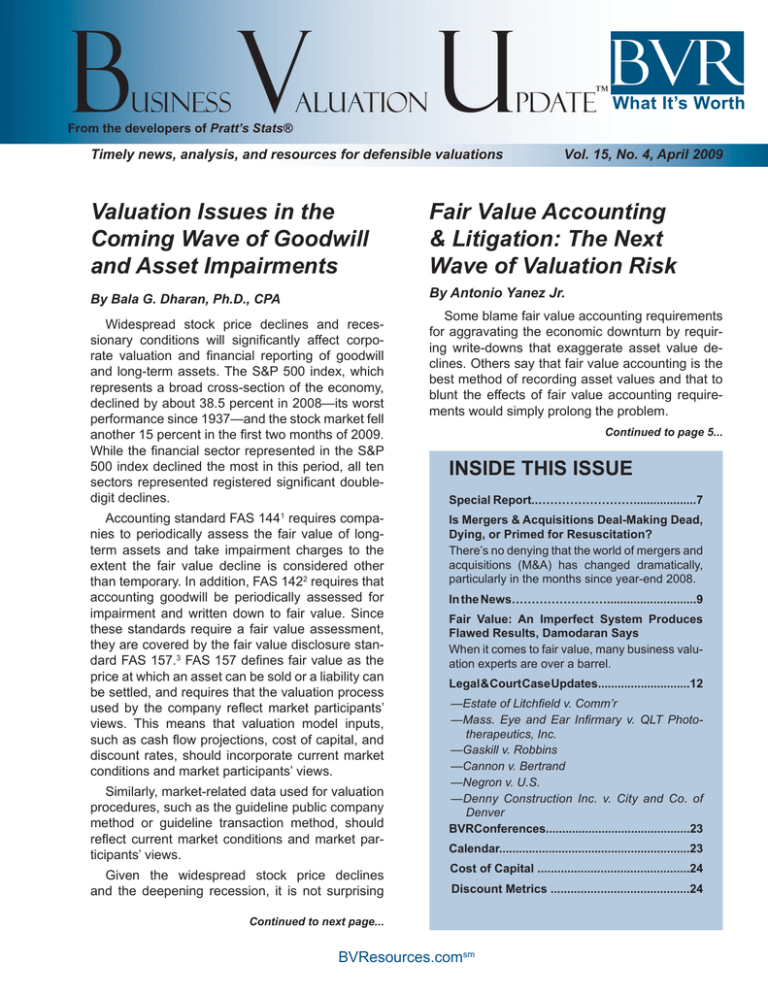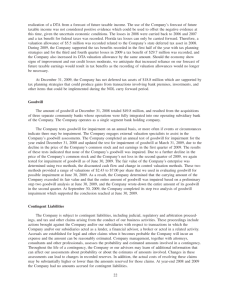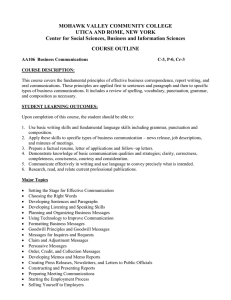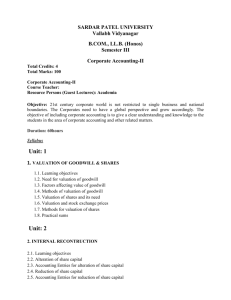
B V
USINESS
ALUATION
From the developers of Pratt’s Stats®
U
BVR
PDATE
Timely news, analysis, and resources for defensible valuations
™
What It’s Worth
Vol. 15, No. 4, April 2009
Valuation Issues in the
Coming Wave of Goodwill
and Asset Impairments
Fair Value Accounting
& Litigation: The Next
Wave of Valuation Risk
By Bala G. Dharan, Ph.D., CPA
By Antonio Yanez Jr.
Widespread stock price declines and recessionary conditions will significantly affect corporate valuation and financial reporting of goodwill
and long-term assets. The S&P 500 index, which
represents a broad cross-section of the economy,
declined by about 38.5 percent in 2008—its worst
performance since 1937—and the stock market fell
another 15 percent in the first two months of 2009.
While the financial sector represented in the S&P
500 index declined the most in this period, all ten
sectors represented registered significant doubledigit declines.
1
Accounting standard FAS 144 requires companies to periodically assess the fair value of longterm assets and take impairment charges to the
extent the fair value decline is considered other
than temporary. In addition, FAS 1422 requires that
accounting goodwill be periodically assessed for
impairment and written down to fair value. Since
these standards require a fair value assessment,
they are covered by the fair value disclosure standard FAS 157.3 FAS 157 defines fair value as the
price at which an asset can be sold or a liability can
be settled, and requires that the valuation process
used by the company reflect market participants’
views. This means that valuation model inputs,
such as cash flow projections, cost of capital, and
discount rates, should incorporate current market
conditions and market participants’ views.
Similarly, market-related data used for valuation
procedures, such as the guideline public company
method or guideline transaction method, should
reflect current market conditions and market participants’ views.
Given the widespread stock price declines
and the deepening recession, it is not surprising
Some blame fair value accounting requirements
for aggravating the economic downturn by requiring write-downs that exaggerate asset value declines. Others say that fair value accounting is the
best method of recording asset values and that to
blunt the effects of fair value accounting requirements would simply prolong the problem.
Continued to page 5...
INSIDE THIS ISSUE
Special Report..……………………...................7
Is Mergers & Acquisitions Deal-Making Dead,
Dying, or Primed for Resuscitation?
There’s no denying that the world of mergers and
acquisitions (M&A) has changed dramatically,
particularly in the months since year-end 2008.
In the News……………………...........................9
Fair Value: An Imperfect System Produces
Flawed Results, Damodaran Says
When it comes to fair value, many business valuation experts are over a barrel.
Legal & Court Case Updates............................12
—Estate of Litchfield v. Comm’r
—Mass. Eye and Ear Infirmary v. QLT Phototherapeutics, Inc.
—Gaskill v. Robbins
—Cannon v. Bertrand
—Negron v. U.S.
—Denny Construction Inc. v. City and Co. of
Denver
BVRConferences............................................23
Calendar..........................................................23
Cost of Capital ..............................................24
Discount Metrics ..........................................24
Continued to next page...
BVResources.comsm
BUSINESS VALUATION UPDATE
Executive Editor:
Lisa Isom
Legal Editor:
Contributing Editors:
Sherrye Henry Jr.
Paul Heidt & Adam Manson
Publisher:
Production Manager:
President:
Doug Twitchell
Laurie Morrisey
Lucretia Lyons
Customer Service:
Stephanie Crader
Sales:
Linda Mendenhall
Chair and CEO:
David Foster
Editorial Advisory Board
NEIL J. BEATON, CPA/ABV,
CFA, ASA
Z. CHRISTOPHER MERCER,
ASA, CFA
Grant Thornton
Seattle, Wash.
Mercer Capital
Memphis, Tenn.
JOHN A. BOGDANSKI, Esq.
JOHN W. PORTER
Lewis & Clark Law School
Portland, Ore.
Baker & Botts
Houston, Texas
NANCY J. FANNON,
ASA, CPA/ABV, MCBA
JAMES S. RIGBY, ASA, CPA/
ABV
Fannon Valuation Group
Portland, Me.
IN MEMORIAM (1946 – 2009)
JAY E. FISHMAN, FASA, CBA
RONALD L. SEIGNEUR,
MBA CPA/ABV CVA
Financial Research Associates
Bala Cynwyd, Pa.
Seigneur Gustafson
Lakewood, Colo.
LYNNE Z. GOLD-BIKIN, Esq.
BRUCE SILVERSTEIN, Esq.
Wolf, Block, Schorr & Solis-Cohen
Norristown, Pa.
Young, Conaway, Stargatt & Taylor
Wilmington, Del.
LANCE S. HALL, ASA
JEFFREY S. TARBELL,
ASA, CFA
FMV Opinions
Irvine, Calif.
JAMES R. HITCHNER, CPA/
ABV, ASA
The Financial Valuation Group
Atlanta, Ga.
JARED KAPLAN, Esq.
Houlihan Lokey
San Francisco, Calif.
GARY R. TRUGMAN,
ASA, CPA/ABV, MCBA, MVS
Trugman Valuation Associates
Plantation, FL
McDermott, Will & Emery
Chicago, Ill.
KEVIN R. YEANOPLOS,
CPA/ABV/CFF, ASA
GILBERT E. MATTHEWS,
CFA
Brueggeman & Johnson Yeanoplos, P.C.
Tucson, AZ
Sutter Securities Incorporated
San Francisco, Calif.
Business Valuation Update™ (ISSN 1088-4882) is published monthly by Business
Valuation Resources, LLC, 1000 SW Broadway, Suite 1200, Portland, OR, 972053035. Periodicals Postage Paid at Portland, OR, and at additional mailing offices. Postmaster: Send address changes to Business Valuation Update™, Business Valuation
Resources, LLC, 1000 SW Broadway, Suite 1200, Portland, OR, 97205-3035.
The annual subscription price for the Business Valuation Update™ is $339. Low cost
site licenses are available for those wishing to distribute the BVU to their colleagues at
the same address. Contact our sales department for details. Please feel free to contact
us via email at customerservice@BVResources.com, via phone at 503-291-7963, via
fax at 503-291-7955 or visit our website at BVResources.com. Editorial and subscription requests may be made via email, mail, fax or phone.
Please note that by submitting material to BVU, you are granting permission for the
newsletter to republish your material in electronic form.
Although the information in this newsletter has been obtained from sources that BVR
believes to be reliable, we do not guarantee its accuracy, and such information may be
condensed or incomplete. This newsletter is intended for information purposes only,
and it is not intended as financial, investment, legal, or consulting advice.
Goodwill and Asset Impairments
that several companies have in recent weeks announced large write-downs of goodwill, intangible
assets, and other assets. Recent corporate announcements of multi-billion dollar goodwill and
asset write-offs include Time Warner ($25 billion),
ConocoPhillips ($35 billion), Regions Financial ($6
billion), and Royal Bank of Scotland ($33 billion4).
One should expect to see more such announcements of asset write-offs in the coming weeks and
months. Goodwill is particularly vulnerable to large
write-offs. Because of the wave of mergers and
acquisitions that started in the late 1990s, goodwill is now a large percentage of the total assets
of many corporations, so goodwill write-offs, when
they occur, can be significant. In general, technology, media, energy, and consumer products companies tend to have large goodwill accounts due to
industry consolidations and acquisition activities.
For some technology companies, such as Cisco
Systems, Inc., goodwill is the largest non-current
asset on the balance sheet.
According to a research report cited by The
Economist, goodwill in corporate balance sheets
totals about $2.6 trillion.5 A large portion of this
goodwill undoubtedly resulted from mergers and
acquisitions completed at the height of the stock
market valuation in the 2004-2007 period. These
transaction valuations have to be reassessed given the stock market decline and the recession’s effect on projected cash flows. It is easy to see that
the resulting goodwill write-off may add up to several hundreds of billions of dollars, rivaling in magnitude the initial wave of 2008 losses recognized
from mortgage-related assets.
If history is any guide, we may also see several
lawsuits against companies—and their advisors—
following the asset impairment announcements
related to the amount and the timing of these impairment charges as well as the alleged damages
based on stock price declines. A late-2008 impairment announcement by CBS Corporation provides
an illustration. During 2008, the stock price of CBS
declined considerably, falling almost 50 percent by
September 30, 2008.6 On October 10, 2008, the
company announced that “as a result of adverse
market conditions,” it conducted an impairment
analysis of goodwill and intangible assets that resulted in a goodwill write-off of about $9.6 billion and
an additional write-off of about $4.6 billion in other
intangible assets. In December 2008, a purported
class action lawsuit was filed against the company
Copyright 2009, Business Valuation Resources, LLC, (BVR). All rights reserved. No
part of this newsletter may be reproduced without express written consent from BVR.
2
Business Valuation Update
april 2009
Goodwill and Asset Impairments
alleging, among others, the “failure to timely writedown impaired intangible and goodwill assets.”
Goodwill write-offs and stock price declines.
For goodwill and other non-financial assets, the
purpose of periodic fair value evaluation is to determine whether “impairment” in the value of the
asset has occurred, i.e., whether the fair value of
the asset is less than the asset’s balance sheet
“carrying value.” If the fair value evaluation suggests that an “other than temporary” impairment
of fair value has occurred, then the company must
write-down the carrying value of the asset on the
balance sheet to the estimated fair value and recognize a corresponding impairment charge (loss)
in its income statement. Factors considered for
tests of impairment vary by the type of asset evaluated. In testing the goodwill asset for impairment,
the market capitalization of the firm is often considered relevant. This is why the recent stock price
declines are likely to lead to an increase in goodwill
impairment tests, although a falling stock price is
neither necessary nor sufficient for the recognition
of impairment of goodwill or other assets.
To understand why stock price declines could
precipitate a goodwill impairment test, it is useful to
review the accounting basics for goodwill recognition and write-off. The goodwill account on the balance sheet is created when a firm acquires another
firm or its assets and liabilities for a price that is in
excess of the estimated fair values of the individual
assets and liabilities acquired. FAS 142 requires
that fair values are first determined at the so-called
reporting unit level for all identifiable assets and
liabilities acquired, including acquired intangible
assets such as brands, royalties, and copyrights.
Goodwill is then the excess of the price paid over
the fair values of all identifiable assets less liabilities acquired.
Goodwill thus essentially represents unidentifiable intangible benefits from acquisition. For example, FAS 142 suggests that goodwill may be due
to, among others, the “control premium” over fair
values that a buyer would pay to get acquisitionrelated synergies. FAS 142 states: “Substantial
value may arise from the ability to take advantage
of synergies and other benefits that flow from control over another entity...An acquiring entity often is
willing to pay more for equity securities that give it a
controlling interest than an investor would pay for a
number of equity securities representing less than
a controlling interest. That control premium may
cause the fair value of a reporting unit to exceed
april 2009
its market capitalization. The quoted market price
of an individual equity security, therefore, need not
be the sole measurement basis of the fair value of
a reporting unit.”7
Impairment and consideration of stock prices. FAS 142, of course, requires that goodwill, once
created, should be carried indefinitely at its original
value without amortization unless an impairment
analysis of the fair value of the reporting unit level
indicates that goodwill has been impaired. Such a
test for goodwill impairment must be done at least
annually and also in the interim between annual
tests “if an event occurs or circumstances change
that would more likely than not reduce the fair value
of a reporting unit below its carrying amount.”8
FAS 142 lists several examples of events or
changed circumstances that might require an interim
test for goodwill impairment. Although none of these
examples specifically refers to a decline in the stock
market value of the company as a trigger for goodwill
impairment analysis, major accounting firms have
stated that a significant stock price decline may be
a potential event or changed circumstance requiring
an impairment analysis for goodwill. For example,
an Ernst & Young publication dated October 2008
states: “A significant decline in a company’s stock
price may suggest that the fair value of one or
more reporting units has fallen below their carrying
amounts. Similarly, declines in the stock prices of
other companies in a reporting unit’s industry may
suggest that an interim test for goodwill impairment
is required.”9 Similar comments on the potential for
goodwill write-offs due to recent stock price declines
have been included in recent publications by other
major accounting firms.10
The SEC’s view on stock price decline and
goodwill impairment. The Securities and Exchange Commission (SEC) has also said that it expects more goodwill impairment than usual due to
the recent declines in stock prices. Robert Fox, III,
a Professional Accounting Fellow at the SEC, said
at a recent accounting conference that the need
to test for goodwill impairment required judgment
and that “this judgment may be more challenging in
the current environment due to recent market declines that indicate that a potential impairment exists.”11 He added that the SEC “would expect more
goodwill impairment than in recent years...” in the
upcoming financial filings.
At the same conference, Steven Jacobs, an Associate Chief Accountant at the SEC, indicated
that a “decline in market capitalization below book
Business Valuation Update
3
Goodwill and Asset Impairments
value,” including the “duration and severity of [the]
difference,”12 would be an impairment testing indicator for goodwill, assuming factors such as shortterm volatility are ruled out as the causes. More
interestingly, Mr. Jacobs noted that even in cases
where a current impairment charge of goodwill
is not taken, companies may be required to provide “early warning disclosures” of potential future
goodwill impairment charges if there is a reasonable possibility of loss. These remarks by SEC staff
members suggest that the SEC would be looking
for an explanation from corporations on how they
considered current stock price declines when analyzing goodwill impairment.
The SEC staff appears to have already made
these kinds of inquiries during 2008 in some of
its “comment letters” sent to companies requesting clarifications related to their 10-K and 10-Q filings. For example, in a comment letter to Regions
Financial Corporation dated June 17, 2008, the
SEC staff asked the company to explain, “How you
determined that your goodwill balance is not impaired. Please specifically address how you took
into consideration the fact that you have been
trading at a market value that is below your book
value.”13 The company, in its reply filed on July 1,
2008, responded that, “management could not
conclude that [lower market value] was a longterm trend, particularly when our stock price was
trading above book value in the fourth quarter of
2007. Further, given the relatively small difference
between our stock price and our book value per
share, we determined that a potential buyer would
offer a control premium for our business franchise
that would adequately cover these differences between trading prices and book values.”
As Regions Financial explained, a commonly
claimed mitigating factor when the market value of
a company is below its book value is whether the
goodwill on the balance sheet represents (or may
be justified by) the control premium that a current
buyer would pay for the company. Clearly, there is
judgment involved in determining the amount of
control premium for a reporting unit. However, the
SEC’s Fox, the speaker at the above-mentioned
AICPA national conference, cautioned that companies should be prepared to justify the assumptions
of control premiums that current buyers would pay
given the significant fall in stock prices last year.
Fox said, “I would also note that the amount of supporting evidence supporting your judgment would
4
likely be expected to increase as any control premium increases.”
Valuation and economic effects. Goodwill and
asset impairment charges are generally considered “non-cash” in nature, i.e., they affect earnings
but not cash flows from operations. Nevertheless,
there may be stock price effects from goodwill announcements depending on the extent to which the
information is a surprise to the market. In addition,
stock price effects will also depend on whether the
impairment charges could affect a company’s future operations and cash flows.
The effect on cash flows is hard to predict, and
it would depend on how the impairments—and the
resulting earnings decline—affect the company’s
loan covenants, employment agreements, compensation plans, etc. Goodwill and asset impairment
will also affect several financial ratios used in loan
covenants and used by financial analysts to evaluate risk and returns. For example, large goodwill or
other asset impairments would increase the debtequity ratio and could cause violations of some
ratio-based loan covenants. There could also be
analyst rating changes and credit rating changes
that could increase the cost of borrowing. Earnout contracts and contingency payments related
to mergers and acquisitions could be dependent
on reported earnings, which could affect the cash
flows related to these contracts. Valuation specialists and accountants need to consider these potential effects in evaluating the possible valuation
consequences of goodwill and asset impairment.
________________
About the author: Bala Dharan is a vice president in the financial accounting and valuation group at CRA International,
Inc., a global business, financial and economic consulting
firm. Dharan is also a visiting professor of accounting at
Harvard Law School.
1. Statement of Financial Reporting Standard No. 144, “Accounting for the Impairment or Disposal of Long-Lived
Assets,” Financial Accounting Standards Board, August
2001, as amended. The corresponding International
Financial Reporting Standard (IFRS) 5, “Non-current
Assets Held for Sale and Discontinued Operations,”
International Accounting Standards Board, is similar
to FAS 144.
2. Statement of Financial Accounting Standard No. 142,
“Goodwill and Other Intangible Assets,” Financial Accounting Standards Board, June 2001, as amended.
The corresponding international financial reporting
standard is similar. See IAS 36, “Impairment of Assets,”
International Accounting Standards Board.
Business Valuation Update
april 2009





